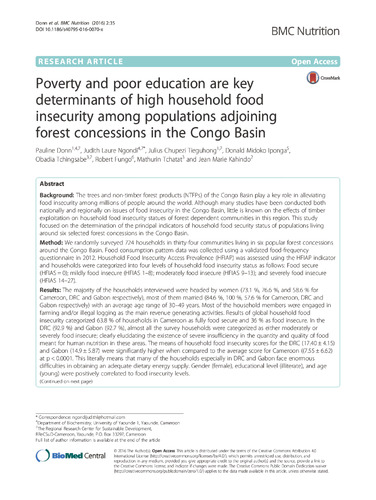Poverty and poor education are key determinants of high household food insecurity among populations adjoining forest concessions in the Congo Basin
Background:
The trees and non-timber forest products (NTFPs) of the Congo Basin play a key role in alleviating food insecurity among millions of people around the world. Although many studies have been conducted both nationally and regionally on issues of food insecurity in the Congo Basin, little is known on the effects of timber exploitation on household food insecurity statues of forest dependent communities in this region. This study focused on the determination of the principal indicators of household food security status of populations living around six selected forest concessions in the Congo Basin.
Method:
We randomly surveyed 724 households in thirty-four communities living in six popular forest concessions around the Congo Basin. Food consumption pattern data was collected using a validated food-frequency questionnaire in 2012. Household Food Insecurity Access Prevalence (HFIAP) was assessed using the HFIAP indicator and households were categorized into four levels of household food insecurity status as follows: Food secure (HFIAS = 0); mildly food insecure (HFIAS 1–8); moderately food insecure (HFIAS 9–13); and severely food insecure (HFIAS 14–27).
Results:
The majority of the households interviewed were headed by women (73.1 %, 76.6 %, and 58.6 % for Cameroon, DRC and Gabon respectively), most of them married (84.6 %, 100 %, 57.6 % for Cameroon, DRC and Gabon respectively) with an average age range of 30–49 years. Most of the household members were engaged in farming and/or illegal logging as the main revenue generating activities. Results of global household food insecurity categorized 63.8 % of households in Cameroon as fully food secure and 36 % as food insecure. In the DRC (92.9 %) and Gabon (92.7 %), almost all the survey households were categorized as either moderately or severely food insecure; clearly elucidating the existence of severe insufficiency in the quantity and quality of food meant for human nutrition in these areas. The means of household food insecurity scores for the DRC (17.40 ± 4.15) and Gabon (14.9 ± 5.87) were significantly higher when compared to the average score for Cameroon ((7.55 ± 6.62) at p < 0.0001. This literally means that many of the households especially in DRC and Gabon face enormous difficulties in obtaining an adequate dietary energy supply. Gender (female), educational level (illiterate), and age (young) were positively correlated to food insecurity levels.
Conclusion:
Our results revealed that, despite the potential contribution of the Congo Basin forests, through enhancing access to different forms of quality foods such as bush meat, wild foods, and medicine, not forgetting the provision of agricultural land, local construction material, and income generation resources, the prevalence of food insecurity among the population adjoining forest concessions in the region is severe. This prevalence is alarming around forest concessions of the DRC and Gabon and in one concession of Cameroon. Given that poverty and poor education were positively correlated to household food insecurity, they were considered the paramount determinants of household food insecurity in this region.

